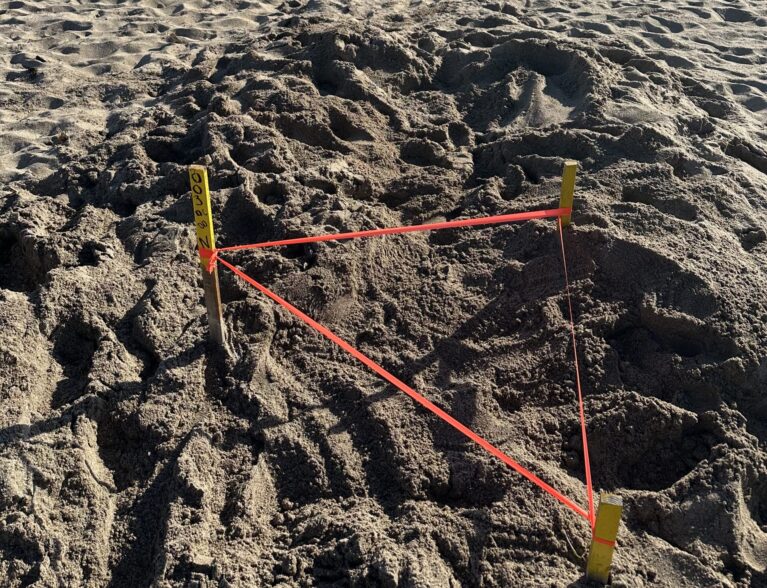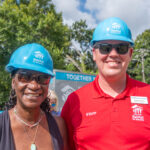
INDIAN RIVER COUNTY — Keeping the beaches clean, flat and dark will help protect nests laid by sea turtle species that are considered endangered – Loggerheads, Greens and Leatherbacks.
Those are the guidelines Indian River County officials are giving to beachgoers as they make their way to the Treasure Coast’s sandy shorelines this spring. With sea turtle nesting season in full swing, beach visitors should keep their distance from sea turtle nests, take all of their belongings when they leave and flatten out any sandcastles they make, said Quintin Bergman, coastal resource manager for Indian River County.
Those visiting the beach should refrain from using flashlights, or any other electric light, at night.
“The turtles nest at night. They might bump into a sandcastle. Fill in any holes. You don’t want hatchlings or an adult turtle to fall in the hole,” said Bergman, who previously studied sea turtles in Costa Rica and Greece before joining Indian River County’s Coastal Division in 2019. “Turtles are impacted by artificial light. Keeping the beach dark will help the babies find the ocean and attract more nesting adults.”
Sea turtle nesting season runs from March 1 through October 31.
Six Leatherback nests have emerged so far this year along the Indian River County beaches. The Leatherback species is usually the first to kick off the nesting season, followed by the Loggerheads in April and then the Greens in May, according to county officials.
“The nests that are marked will be observed until they hatch,” Bergman said. “They’re evaluated for reproduction success.”
Bergman said sea turtles lay the most nests during the summer months, and that numbers are usually low in the spring.
In 2024, sea turtles laid more than 8,000 nests underneath the sand on Indian River County beaches, Bergman said. Loggerheads had 7,223 nests, while Greens had 782 and the Leatherbacks had 52, according to the 2024 Sea Turtle Nesting Season Public Data Dashboard.
Bergman said last year’s nesting numbers in Indian River County match the annual average for the area.
“Greens and Leatherbacks are more endangered than Loggerheads,” Bergman said. “We’re centrally located in an environment where (sea turtles) nest. We always get nests for the three endangered species, and no other species, in Indian River County.”
Weather plays a factor in forming a hatchling’s gender, according to Bergman. Bergman said the temperature of the sand during incubation determines the gender of the turtle.
Hot sand produces more female turtles, while cooler sand makes more male turtles, according to the National Ocean and Atmospheric Administration.
“One turtle can lay between four-to-six nests in one season. They put all of their energy into producing the next batch of eggs.” Bergman said. “Every time she comes to lay a nest it’s in a different location. Between nest-layings, (the turtles) find a spot offshore to use as a little energy as possible.”
Beachgoers should not get close to the sea turtles because they might scare or cause stress to the animals, Bergman said. As the county replenished sand swept away by erosion from Hurricanes Ian, Nicole and Milton, crews installed a turtle-friendly slope for the shelled, ancient creatures that is not too deep.
“There is a strict specification on the sand grain size and color,” Bergman said. Most of the nests hatched before tornadoes spawned by Hurricane Milton swooped through Indian River County last October, officials said.
Bergman said county officials do not encourage people to go out looking for the nests on their own. Instead, turtle watchers can find a permitted organization that hosts nighttime turtle walks or daytime nest evaluations.
“We have to get permits with the Florida Fish and Wildlife Conservation Commission to work with sea turtles,” Bergman said. “The best time to see a hatchling is 8 a.m.”
Some organizations in Indian River and Brevard counties with permits to host sea turtle walks include Coastal Connections, Friends of Sebastian Inlet, Friends of the Carr Refuge and Sea Turtle Conservancy. Bergman said the closest turtle rehabilitation complex is the Loggerhead Marine Life Center in Juno Beach.
Coastal Connections will be hosting its annual Tipsy Turtle 2 Mile Fun Run and Festival on April 19 in Vero Beach. Those who want more information on the event can visit the Coastal Connections website.






